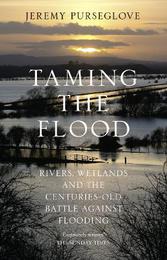
|
Taming the Flood: Rivers, Wetlands and the Centuries-Old Battle Against Flooding
Paperback / softback
Main Details
| Title |
Taming the Flood: Rivers, Wetlands and the Centuries-Old Battle Against Flooding
|
| Authors and Contributors |
By (author) Jeremy Purseglove
|
| Physical Properties |
| Format:Paperback / softback | | Pages:400 | | Dimensions(mm): Height 198,Width 129 |
|
| Category/Genre | Conservation of the environment
The Earth - natural history general |
|---|
| ISBN/Barcode |
9780008132217
|
| Classifications | Dewey:333.9180941 |
|---|
| Audience | |
|---|
| Illustrations |
40 b/w illus, (4-page colour plate section), Index
|
|
Publishing Details |
| Publisher |
HarperCollins Publishers
|
| Imprint |
William Collins
|
| Publication Date |
9 February 2017 |
| Publication Country |
United Kingdom
|
Description
Beautifully written and magnificently illustrated with photographs, line drawings and maps, this book serves both as a celebration of the richness of the British countryside, and as a warning of the legacy of loss and destruction we could so easily leave to future generations. In recent years the Somerset Levels suffered from the worst flooding in over twenty years, and more recently, flooding in Cumbria and other parts of Britain have reached new levels of severity. Taming the Flood analyses many of the conflicting demands made on rivers and wetlands, offering practical solutions which aim to protect, rather than destroy, these important ecological habitats. Exploring the old arguments and new solutions raised over the last 400 years, this completely updated edition of the classic Taming the Flood reveals how harnessing nature, rather than attempting to repress it, is the only answer to the environmental disasters we are faced with today. As a practical landscape architect and ecologist working in the water industry, Jeremy Purseglove has been actively involved in land drainage engineering to try to enhance, rather than destroy, the heritage of our rivers and wetlands. He charts the conservation, agriculture and development of our rivers and wetlands, outlining practical proposals for the protection and use of these sensitive habitats. From the Lancashire mosses and the Derwent Ings, Otmoor and the Fens, to Romney Marsh and the Somerset Levels, he traces the history and natural history of our rivers and wetlands, describing in vivid detail both the beauty of these strange and ancient landscapes, and the often disastrous results of attempts to tame them.
Author Biography
Jeremy Purseglove helped to pioneer a new approach to the way we manage our rivers, having worked as an environmentalist in the water industry for over a decade. Taming the Flood, first published in 1988, is based on his personal experience and on the research he did for a television series, which he also presented. In 1989 he left the water industry to join an engineering consultancy. In this capacity he worked in the UK and throughout the world integrating civil engineering schemes with the environment. He lives in Cambridge.
Reviews'His original determination remains the driving force of this compelling book. Mr Purseglove's mission was to show why rivers really matter to England and how our wetlands are a vital part of the natural scene. His descriptions are wonderfully accurate, his writing captivating and his enthusiasm catching. On any level, it's a good read, but, as a call to action, it's outstanding [...] It is his love of the subject, his deep knowledge and poetic insight that wins us from the very first page.' John Selwyn Gummer, Country Life magazine 'Taming the Flood most deserves its status as a classic [...] for its evocation of place [...] the descriptions of wetlands are exquisitely written. This fine book calls for, and takes, a longer view.' The Sunday Times Praise for the previous edition: 'Jeremy Purseglove has a gift that is increasingly rare in these days of scientific specialisation - of joining practical wisdom about working with nature and the land to an imaginative appreciation of their place in our history and culture.' Richard Mabey 'A most authoritative book which appears at a very appropriate time. It will give rise to new attitudes in an extremely important aspect of conservation, and new hope to those who are fighting for a more enlightened approach to wetlands.' Sir Peter Scott
|